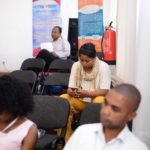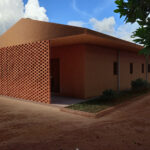
#Madagascar
In September 2020, our journey led us to delve into the realm of traditional construction. Today, I’ll take you through how our small, yet mighty, shoe-box office, fueled by an exceptional team of designers and skilled technicians, embraced an economical and environmentally-conscious approach in our work. It all began with a single wall in Mahamasina.
We were eager to learn from the best, so we invited a Master mason and his team to demonstrate the art of “enduit gasy.” Later on, I’ll share more about the ingredients, hidden gems, and techniques that are renowned for their water-resistant and infestation-proof performance across the globe. It’s interesting how, back home, we tend to overlook these methods just because the term “gasy” is part of it. Yet, in reality, it’s nothing more than a highly lateritic pigmented soil-cement mortar coating. Simple, right? Duh!

https://www.facebook.com/tranoarchitecture/videos/682470436076420
Back in September 2020, we faced the unmistakable signs of price hikes in construction materials, coupled with the challenges brought on by multiple lockdowns due to Covid-19 restrictions. It was a turning point that prompted deep reflection on our heavy reliance on imported materials. I must admit that I had little to no training in natural, local, and traditional construction techniques. Nevertheless, this situation presented a golden opportunity for us to embrace and educate ourselves in these age-old processes.
One such method we explored is the use of “poor man’s concrete.” It’s a simple blend of Portland cement, natural soil, and water – that’s all there is to it. Typically utilized for paving surfaces, we observed its potential for external wall coating on an 18th-century heritage trano gasy house. The idea of adapting this technique for such a historically significant structure intrigued us, and we’re eager to delve further into the rich history of earth-based construction in Madagascar.
Throughout this journey, we’ve realized that by tapping into our indigenous resources and ancient wisdom, we can not only navigate price fluctuations but also rediscover sustainable and locally-sourced construction practices. We’re excited to share more about the century-old tradition of using earth for building in Madagascar as we continue to expand our knowledge in this fascinating realm.

“They’re stewing the recipe,” Rakotoseheno Rado, our in-house architect and trano gasy specialist, explained expertly as he observed the masons skillfully preparing the earth-based plaster. Curiosity got the best of me, and I couldn’t resist asking, “What do they put inside?” It seemed to be sticking together after stewing for hours. “I’ve seen zebu leather, some grass, and everything that can maintain this enduring shade of red,” he replied with a hint of admiration.
I must confess, I never expected cooking to be part of the construction process. This initial encounter with Master masons sharing their expertise was truly enlightening. Witnessing their meticulous work peeling off the cement-based coating from this early 19th-century uphill Haute-Ville house took weeks. And even more weeks were invested in applying the “Enduit gasy,” resulting in this exquisite Lava-Laterit-Tany-Gasy shade, which serves as the final touch before painting.
Preserving a more than 200-year-old house demands making the best choices, and that involves relying on local expertise and exercising patience, as I have come to understand firsthand.

In a nutshell, this represents our very own sample of “enduit gasy,” exuding the warmth and solid properties of earth. It has been here for over 14 months now. Throughout our journey, we have deliberately chosen to stick to these traditional building methods and sought guidance from numerous experts, gathering their insights and recipes. Our aspiration is to inspire more individuals to embrace innovation with traditional materials and techniques.
During our next workshop, we will share our experiences with Earth-Block Compressed, also known as BTC (Brique de Terre Compressée). Additionally, we persist in advocating for the use of “enduit gasy” as an exterior plaster in some of our ongoing projects, even though we have received validation from clients. Regrettably, only a handful of contractors have accepted this approach. Similarly, with BTC, we won’t hold back in shedding light on the challenges we encountered during our journey towards a more sustainable and locally sourced form of architecture.
find more about our journey to sustainable building in Madagascar with Episode #2


















